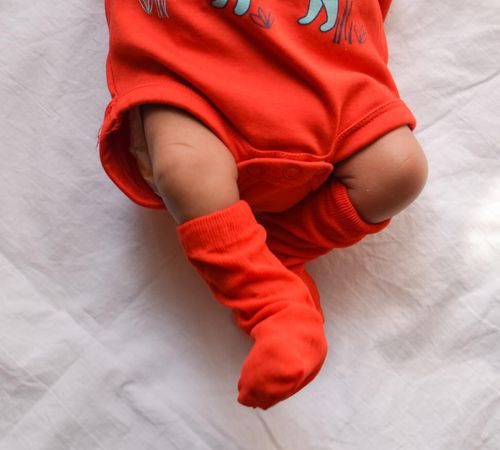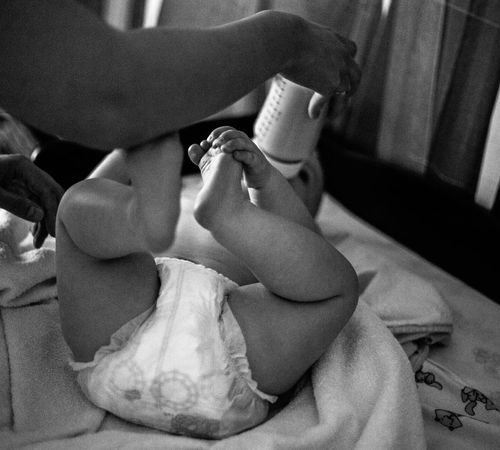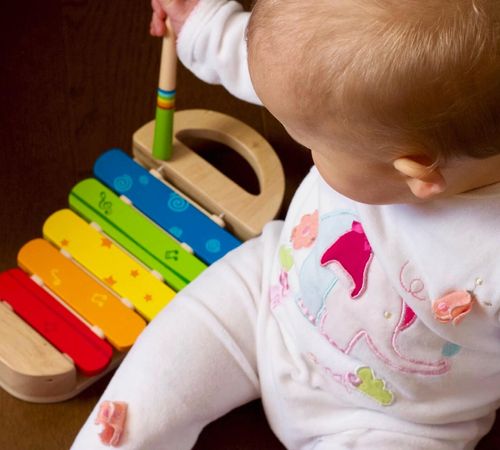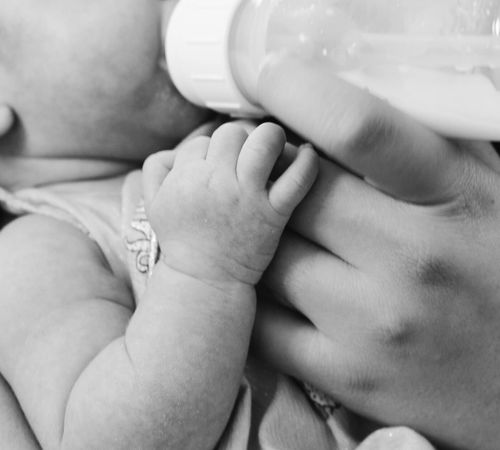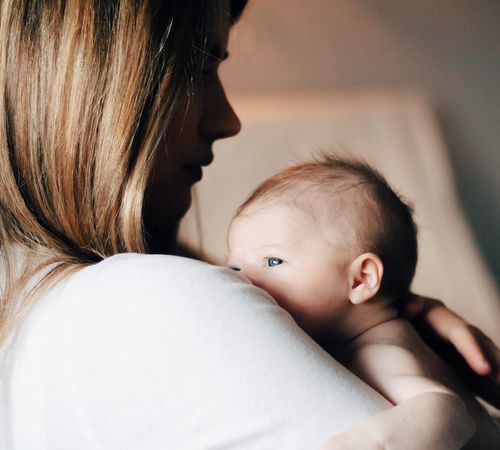Is your baby resisting the last nap of the day? Learn when babies are ready to make the 3 to 2 nap transition and how to smoothly drop a nap without having a possibly overtired baby on your hands.
You finally figured it out. The biggest mystery in the entire universe. There it is, in all its glory.
Your nap schedule.
It works. It finally works. You know when that baby is going to sleep. You are out with friends, and you tell them that you have to go in exactly half an hour because YOU KNOW your baby is going to sleep. It's just beautiful.
But as I always like to say, there is nothing guaranteed in parenthood, especially when it comes to baby sleep.
Suddenly, your baby is not interested in napping anymore. It takes forever to get them to sleep. And now you wonder: do they need to drop that nap? Can they make it until bedtime without that extra sleep? You find yourself in between they-need-that-nap-or-they-get-overtired vs. I-cannot-get-them-to-sleep-anymore-at-bedtime.
But figuring out if your baby is ready to drop the third nap of the day does not have to be such a mystery.
In this article, we will discuss what a nap transition is, when babies transition to two naps, what signs you should look out for, and how to help your baby drop that nap smoothly.
This article covers:
What is a Nap Transition?
The process of dropping a daytime nap is called nap transition.
Until the age of approx. 3 years, the amount of your child's daytime sleep will naturally decrease, and they will need fewer naps during the day. They will drop one nap after another until they eventually don't sleep during the day anymore.
When your child drops from having 3 to having 2 naps, it is considered a nap transition.
When Do Babies Transition To Two Naps?
While sleep needs vary from baby to baby, there is a general range in which babies drop their 3rd nap of the day.
The 3-to-2 nap transition usually happens between 6-9 months. Most babies drop this nap at 7-8 months.
I love when I have to give up another nap...said no mom ever.
Which Nap Should My Baby Drop?
After around 3 months, most babies start to show a more regular sleep pattern during the day with 3 or 4 naps, a morning nap, a lunch nap, and 1-2 afternoon naps.
Until 6 months, babies will have one last nap 1.5-2 hours before bedtime. This afternoon nap is the one you want to drop.
While your baby was staying up around 2 hours between naps, they can now go 3 hours and sometimes even up to 4 hours between the last nap and bedtime.
Having a baby sleep too close to bedtime will start to show now, and undertiredness can become a real thing. Your baby is not tired enough to keep the same bedtime, or they even might start to fight sleep.
What you have to do now is increase the awake time between the last nap and bedtime.
Therefore, it's time to say goodbye to the afternoon nap!
Signs Your Baby Is Ready To Drop The 3rd Nap
Sometimes parents are unsure if their baby is really ready to drop a nap or if they have hit a sleep regression or leap or teething or or or. :)
But if your little one is around the 6-month mark and shows some of these signs for about 2 weeks, it can be an indicator that they are approaching their first real nap transition.
In general, it comes all down to UNDERTIREDNESS. I know that everyone in the baby sleep community is freaking scared about having an overtired baby. But undertiredness is a real thing, guys! Your baby will just sleep as bad when they are undertired.
So here are some signs to watch out for to figure out if your baby is ready to drop a nap:
Getting baby to sleep takes a long time
Your baby is rubbing their eyes, and you are sure they are ready for their nap. I mean, it's their usual nap time. But you can try whatever you want. Getting them to sleep is a real struggle. You walk around with the stroller, jump up and down on the yoga ball, and race from one side of the room to the other with your little one in the carrier, but nothing seems to work.
Your baby seems kinda tired but still has a hard time falling asleep. And getting them finally to fall asleep takes more than a half hour.
Or your baby does not seem tired, and when you try to get them to sleep, they protest loudly. They fight sleep and are definitely not interested in that nap.
Bedtime gets delayed
Your usual bedtime is approaching, but your baby still doesn't show any sleepy cues. You wait and wait and wait, and every 10 more minutes you play with your baby feels like an hour.
No judgment here. I get it. I LOVE an early bedtime! I believe that evenings rightfully belong to me! But you know what that means? You need to cut down on sleep time during the day.
Baby wakes 45 minutes after bedtime
When your baby wakes shortly after bedtime, we refer to it as a false start. One of the main reasons for a false start is undertiredness. Bedtime is more of a short nap for your baby than getting down for the night. They wake up happy after going to bed, and getting them back to sleep can become a real struggle because sleep pressure is too low.
Read more about false starts and how to solve them in this article:
Baby wakes more often at night
Night sleep will also be affected by too much daytime sleep. Your baby might wake more often during the night, or getting them back to sleep after a feeding becomes more difficult.
In general, you can think about it like this:
If your baby sleeps too much during the day, nighttime sleep gets compensated by daytime naps. Your baby will automatically sleep less during the night.
Early morning wakes
You may not only experience more night wakings, but your baby might also wake early in the morning (before 6 AM) and don't settle back to sleep. They just had enough sleep for the night and are ready to start the day!
Signs Your Baby Is NOT Ready
Your baby's first naps are in total less than 2 hours
At this age, your baby needs about 2 1/2 -3 hours of sleep during the day. If your first naps are short (less than 1 hour) and your baby gets in the remaining sleep through the afternoon nap, then you might want to wait with dropping the nap. Your baby will probably not make it happily to bedtime.
I suggest that you first try for a longer nap, either in the morning or after lunch. You can do so, e.g., by increasing the first or second wake window. If you manage to lengthen one of those naps, you can gradually reduce the length of the afternoon nap until your little one is ready to drop it altogether.
How To Drop A Nap Smoothly
Do not fear, dear parent!
Going through a nap transition doesn't have to be so frightening.
But nap transitions can be tricky for parents because while your baby might be ready to stay awake for a longer period, they can get overtired in the evening.
Or you attempt to drop the nap once and for all, but suddenly your baby seems really tired the other day, and you are back wondering if they actually do still need that nap.
Well, nap transitions are a process. Your baby needs to get used to a longer wake window and a slight change in their sleep pattern. Bedtime may become earlier, and you may need to adjust your sleep schedule. Usually, the transition takes about 1-2 weeks.
So here are my best tips for a smooth nap transition:
1. Embrace the process
Your baby doesn't have to drop the nap instantly. It's much easier if you do it gradually. For example, your baby might skip the nap for one or two days and then need it again the other day. Don't stress about it too much but go with the flow of your baby.
2. Shorten the nap
If your baby is closer to 6 months, they might start to show the first signs of a nap transition. But at the same time, they still need that nap.
This is the perfect time to ease into the nap transition process. You will gradually shorten the nap until you have a cat nap (or power nap as I like to call it) of about 15-20 minutes. A shorter nap will help them get used to a longer wake window.
Your baby might even wake up by themselves because they no longer have such high needs for that nap.
3. Let them nap every other day
If you already have short naps, you can skip the nap every other day and see how your baby handles it. You don't necessarily have to go cold turkey. It's ok if, on some days, your little one still needs a little power nap. It often depends on what you have been doing all day and how much stimulation your baby was exposed to.
4. Let them sleep anywhere
Don't stress about a nap routine or where your baby will sleep for a nap that you are just about to say goodbye to. Achieving this nap will already be more challenging so just let them sleep anywhere during the transition process.
I always advise having naps on the go, in a carrier or a stroller, whatever your baby prefers. Plus, it will be much easier to wake your baby outside than when they are sleeping in their crib. When you wake a sleeping baby at home, they can get quite grumpy. But when they are out, and the world greets them, it's much easier for them (and you).
5. Bring bedtime forward
Staying up until your regular bedtime will be a challenge for your baby in the beginning. So to prevent having an overtired baby, move bedtime slightly forward (30-60 minutes). Keep an earlier bedtime while your baby gets used to the longer awake window. You can still gradually delay bedtime once your baby has completely dropped the nap.
6. Offer a feed or energizing snack
The right food can be energizing and help your baby get through the longer wake window. Offer a healthy snack like a banana, apple purree with oatmeal or raspberries. Your baby might also need another milk feed.
If your baby wants the breast more frequently during that time, don't stress about it. They probably need it as a comfort because they are tired but also don't want to nap, and then there are your boobies...I mean...it's kind of obvious, right.
7. Have low-key afternoons and evenings
You still have a very young baby, and too much stimulation can lead to a pretty fast mood change.
Have low-key afternoons and quiet time in the evening to avoid getting your baby overstimulated.
Example Nap Schedule 3 to 2 Naps
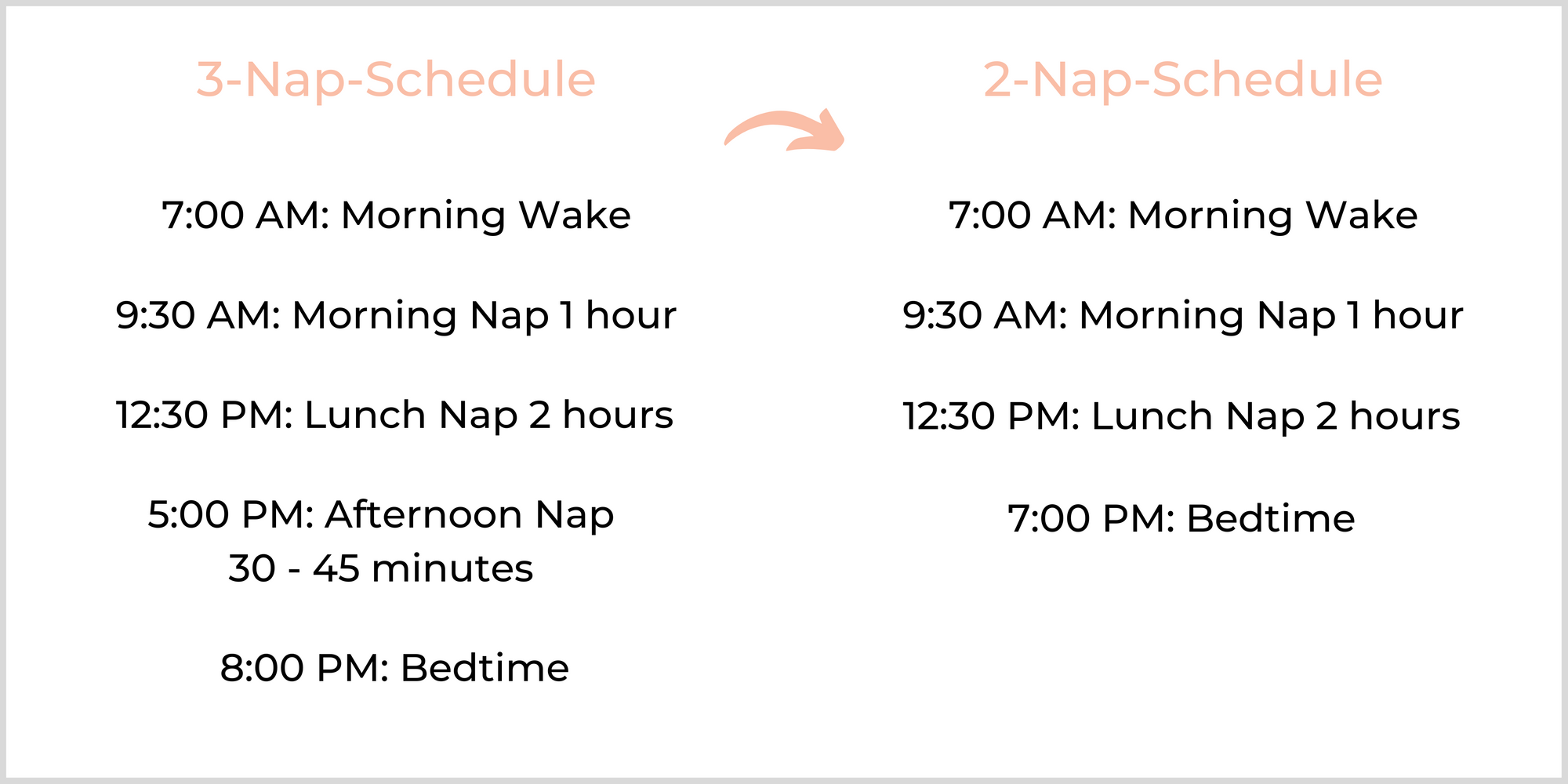
As you can see in the example above, we didn't change the naptime of the first and second nap but moved bedtime from 8:00 PM to 7:00 PM.
If your baby is still struggling with the length of the last wake window, then you can delay the first two naps by about 30 minutes each. This way, the last wake window does not become too long for your baby.
Conclusion
I know it can be a little bit frightening for parents if their baby suddenly starts to refuse their nap. I mean, don't all parents LIVE on naps? And now you are dealing with your first nap transition.
But understand that your baby's sleep will change over the next three years. And you will need to adjust. But the amazing thing is that babies also adjust often faster than we think. And so many things happen naturally without our intervention.
So when you are dealing with your first nap transition right now, be patient with your baby and yourself. You will be through it faster than you might think.



